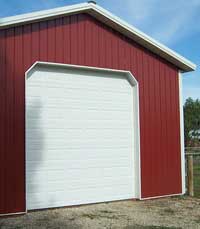Getting a quote on a sectional garage door? Or having one or more of them included either as part of a complete pole building kit package, or being provided by a builder?
Chances are good they are not telling you this story……
About a decade ago, we had provided a pretty good sized (60’ x 60’) pole building kit package to a client in Northern Colorado. Our client erected the building themselves and from the smiling face photos they emailed to me after completion, it looked like they had done a fabulous job!
Around six months after they finished the building, they sent me some more photos – their 12 foot wide by 14 foot tall overhead door had been literally sucked out of the building by approximately 70 mile-per-hour winds!
 Having been in the industry for over 20 years and provided tens of thousands of overhead doors, I had never heard of such a happening, so I dialed up our overhead door supplier. After I explained the situation to him, he told me the typical steel sectional overhead doors provided by not only them, but every other manufacturer, had no wind load rating what-so-ever! I’d never heard of such a thing and was honestly totally flabbergasted.
Having been in the industry for over 20 years and provided tens of thousands of overhead doors, I had never heard of such a happening, so I dialed up our overhead door supplier. After I explained the situation to him, he told me the typical steel sectional overhead doors provided by not only them, but every other manufacturer, had no wind load rating what-so-ever! I’d never heard of such a thing and was honestly totally flabbergasted.
Fortunately, our supplier was quite benevolent and provided the client with brand new replacement door panels at no cost. But it was certainly a lesson learned.
Wind loads are the forces or pressures which are exerted on a structure and the components which make up the structure (like garage and entry doors, windows, etc.) due to wind. These pressures act both toward the building (a positive force), as well as away from (a negative force, or suction). In most cases garage doors are the largest opening(s) on a building and are a critical part of the structural integrity.
Regardless of the version of the Building Code (IBC – International Building Code, or IRC – International Residential Code) the wind load provisions from the American Society of Civil Engineers design standard ASCE 7, Minimum Design Loads for Buildings and Other Structures are utilized for the calculation of wind-load pressures.
These pressure calculations are fairly elaborate and utilize numerous variables which include wind speed, wind exposure (B, C, or D), internal pressure coefficients, the shape of the building and mean roof height.
In order to qualify as wind-load rated garage doors, the doors are required to be tested for a minimum of 10 seconds to a test pressure equal to 1.5 times the rated design pressure for the door.
Some jurisdictions also require wind-load rated garage doors to be tested for wind-borne debris (read more at: https://www.hansenpolebuildings.com/blog/2011/10/wind-rated-garage-doors/).
In order to meet test requirements the garage doors are designed and tested as a complete system. This includes not only the door sections, but also any struts, the track, brackets and supporting hardware. Simply adding reinforcements to a non-wind-load rated door does not necessarily increase the door’s wind resistance.
Crucial to the wind resistance of any garage door system is either locks or a garage door operator to keep the door closed.
What happens if the garage door fails? In many cases the wind pressures on the inside of the building are dramatically increased, which can result in catastrophic failure of some or all of the building.
When in doubt – do it right, specify wind-load rated garage doors.






